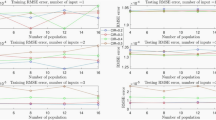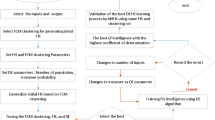Abstract
This paper considers the application of the adaptive neuro-fuzzy inference system (ANFIS) instead of the highly nonlinear model of a reactive batch distillation column for optimization. The architecture has been developed for fuzzy modeling that learns information from a data set, in order to compute the membership function and rule base in accordance with the given input–output data. In this work, the differential evolution algorithm has been employed for optimization of operation policy of reactive batch distillation for producing ethyl acetate. In optimization, minimal batch time and high purity of product are considered, and reflux ratio and final batch time are taken as decision parameters. The results show that the reduced model (ANFIS) is able to properly create a robust model of the reactive batch distillation, and CPU use is reduced to 1/18,000 of that of a real mathematical model. The highest yield and mole fraction of ethyl acetate were achieved through the use of the obtained optimization policy.














Similar content being viewed by others
Abbreviations
- AcOH:
-
Acetic acid (–)
- EtOH:
-
Ethanol (–)
- EtAc:
-
Ethyl acetate (–)
- d :
-
Column diameter (cm)
- WHS:
-
Weir height (cm)
- WLS:
-
Weir length (cm)
- Q R :
-
Reboiler heat input (kJ/h)
- M :
-
Molar liquid holdup on tray (kmol)
- MV:
-
Volumetric liquid holdup on tray (cm3)
- V :
-
Vapor flow rates (kmol/h)
- MwAve :
-
Average molecular weight (kg/kmol)
- DensityAve :
-
Average density (kg/m3)
- D :
-
Distillate flow rates (kmol/h)
- R ij :
-
Chemical reaction rates for jth component on ith tray (1/h)
- NP:
-
Number of population (–)
- pi :
-
Target vector (–)
- pz :
-
Mutant vector (–)
- pu :
-
Trail vector (–)
- CR:
-
Crossover (–)
- U:
-
Dimension space (decision variables) (–)
- Rfmin :
-
Reflux minimum (–)
- Rfmax :
-
Reflux maximum (–)
- \( \bar{X}_{\text{EtAc}}^{{}} \) :
-
Average mole fraction of ethyl acetate at final batch time (–)
- \( X_{\text{EtAc}}^{\min } \) :
-
Minimum mole fraction of ethyl acetate at final batch time (–)
- MSE:
-
Mean squared error (–)
References
Suzuki I, Yagi H, Komatsu H, Hirata M (1971) Calculation of multicomponent distillation accompanied by a chemical reaction. J Chem Eng Jpn 4:26
Komatsu H (1977) Application of the relaxation method for solving reacting distillation problems. J Chem Eng Jpn 10:200–205
Alejski K, Bogacki M, Szymanowski J (1989) Synthesis of ethyl acetate in a reacting distillation column. Polish J Appl Chem 33:509–520
Simandl J, Svrcek WY (1991) Extension of the simultaneous-solution and inside outside algorithms to distillation with chemical reactions. Comput Chem Eng J 15:337–348
Corrigan TE, Ferris WR (1969) A development study of methanol acetic acid esterification. Can J Chem Eng 47:334–335
Agreda VH, Partin LR, Heise WH (1990) High purity methyl acetate via reactive distillation. Chem Eng Prog 86(2):40–46
Komatsu H, Holland CD (1977) A new method of convergence for solving reacting distillation problems. J Chem Eng Jpn 4:292–297
Grosser JH, Doherty FM, Malone MF (1987) Modeling of reactive distillation systems. Ind Eng Chem Res 26:983–989
Bogacki MB, Alejski K, Szymanowski J (1989) The fast method of the solution of a reacting distillation problem. Comput Chem Eng 13:1081–1085
Alejski K (1991) Computation of the reacting distillation column using a liquid mixing model on the plates. Comput Chem Eng 15:313–323
Welch NE, Durbin LD, Holland CD (1964) Mixing on valve trays and in downcomers of a distillation column. AIChE J 10:373–379
Egly H, Ruby V, Seid B (1979) Optimum design and operation of batch rectification accompanied by chemical reaction. Comput Chem Eng 3:169–174
Cuille PE, Reklaitis GV (1986) Dynamic simulation of multicomponent batch rectification with chemical reactions. Comput Chem Eng 10:389–398
Reuter E, Wozny G, Jeromin L (1989) Modeling of multicomponent batch distillation processes with chemical reaction and their control systems. Comput Chem Eng 13:499–510
Espinosa J, Martinez E, Perez G (1994) Dynamic behavior of reactive distillation columns. Equilibrium systems. Chem Eng Commun 128:19–42
Aljeski K, Dupart F (1996) Dynamic simulation of the multicomponent reactive distillation. Chem Eng Sci 51:4237–4252
Schneider R, Noeres C, Kreul LU, Gorak A (2001) Dynamic modeling and simulation of reactive batch distillation. Comput Chem Eng J 25:169–176
Converse AO, Gross GD (1963) Optimal distillate-rate policy in batch distillation. Inst Eng Chem Fund 4:415–477
Diwekar UM, Malik RK, Madhavan KP (1987) Optimal reflux rate policy determination for multicomponent batch distillation columns. Chem Eng Prog 88:43–50
Coward I (1967) The time-optimal problem in binary batch distillation. Chem Eng Sci 22:503–516
Kerkhof LHJ, Visser HJM (1978) On the profit of optimum control in batch distillation. Chem Eng Sci 33:961–970
Logsdon JS, Diwekar UM, Biegler LT (1990) On the simultaneous optimal design and operation of batch distillation columns. Chem Eng Res Des 68:434–444
Fernholz G, Engell S, Kreul LU, Gorak A (2000) Optimal operation of a semi-batch reactive distillation column. Comput Chem Eng 24:1569–1575
Jang JSR (1993) ANFIS: adaptive network-based fuzzy inference systems. IEEE Trans Syst Man Cybern 23(3):665–685
Jang JSR, Sun CT, Mizutani E (1997) Neuro-Fuzzy and soft computing: a computational approach to learning and machine intelligence. Prentice Hall, Upper Saddle River, NJ, pp 199–223
Fernandez de Canete J, Cordero T, Guijas D, Alarcon J (2000) An adaptive Neuro-Fuzzy approach to control a distillation column. Neural Comput Appl 9:211–217
Wilson JA, Martinez EC (1997) Neuro-fuzzy modeling and control of batch process involving simultaneous reaction and distillation. Comput Chem Eng J 21:1233–1238
Eftekhari M, Katebi SD, Karimi M, Jahanmiri AH (2007) Eliciting transparent fuzzy model using differential evolution. Appl Soft Comput 8:466–476
Storn R, Price K (1997) Differential evolution—a simple and Efficient Heuristic for Global Optimization over Continuous Spaces. J Global Opt 11:341–359
Angira R, Babu BV (2006) Optimization of process synthesis and design problems: a modified differential evolution approach. Chem Eng Sci 61:4707–4721
Angira R, Santosh A (2007) Optimization of dynamic systems: a trigonometric differential evolution approach. Comput Chem Eng 31:1055–1063
Babu BV, Angira R (2006) Modified differential evolution (MDE) for optimization of non-linear chemical processes. Comput Chem Eng 30:989–1002
Babu BV, Munawar SA (2007) Differential evolution strategies for optimal design of shell-and-tube heat exchangers. Chem Eng Sci 62:3720–3739
Kaelo P, Ali MM (2006) A numerical study of some modified differential evolution algorithms. Eur J Oper Res 169:1176–1184
Venkateswarlu Ch, Jeevan Kumar B (2006) Composition estimation of multicomponent reactive batch distillation with optimal sensor configuration. Chem Eng Sci 61:5560–5574
Rovaglio M, Doherty MF (1990) Dynamics of heterogeneous azeotropic distillation columns. AIChE J 36:39–52
Luyben WL (1990) Process modeling, simulation, and control for chemical engineering, 2nd edn. McGraw-Hill, New York, p 137
Lee HY, Huang HP, Chien IL (2007) Control of reactive distillation process for production of ethyl acetate. J Proc Cont 17:363–377
Cui ZD, Tang YQ, Yan XX, Yan CL, Wang HM, Wang JX (2009) Evaluation of the geology-environmental capacity of buildings based on the ANFIS model of the floor area ratio. Bull Eng Geol Environ. doi:10.1007/s10064-009-0220-3
Jang R, Sun C (1995) Neuro-fuzzy modeling and control. Proc IEEE 83(3):378–405
Author information
Authors and Affiliations
Corresponding author
Rights and permissions
About this article
Cite this article
Khazraee, S.M., Jahanmiri, A.H. & Ghorayshi, S.A. Model reduction and optimization of reactive batch distillation based on the adaptive neuro-fuzzy inference system and differential evolution. Neural Comput & Applic 20, 239–248 (2011). https://doi.org/10.1007/s00521-010-0364-x
Received:
Accepted:
Published:
Issue Date:
DOI: https://doi.org/10.1007/s00521-010-0364-x




